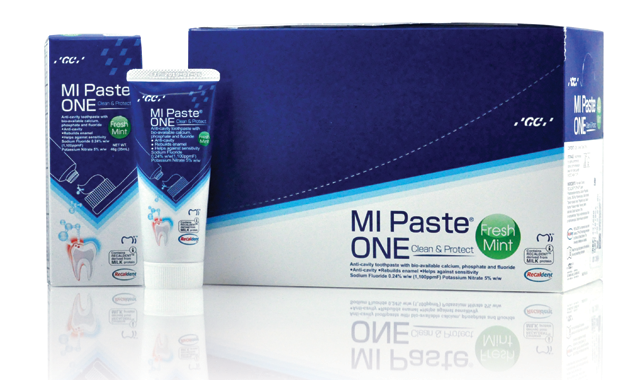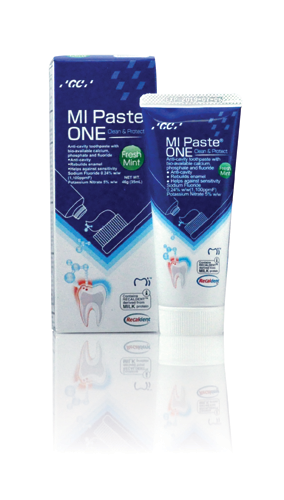How to improve patients’ oral health in one step
MI Paste ONE is a gentle, two-in-one product designed to prevent caries and rebuild tooth enamel.

Chairside dental assistants play essential roles in dental practices and often spend quality time with patients to educate them about dental procedures and proper oral health home care. In this capacity, the nature of the chairside assistant’s interaction with patients provides ideal opportunities for these dental professionals to introduce new treatments and services that the practice offers that could be of interest and benefit to them. Chairside dental assistants are also well positioned to recommend home oral health products that patients could purchase directly from the practice to enhance their home care efforts.

These patient education discussions and home care recommendations are based on the patient’s individual oral health needs and the specific dental problems with which they present. These may include high caries risk, tooth sensitivity and/or enamel wear and erosion, among other conditions.
Caries is a far-reaching oral health problem that affects individuals of all ages. Caries result from the infiltration of harmful bacteria in the mouth, particularly around natural teeth and around and under restorations.1 Specifically implicated in the caries process are Streptococcus mutans, Streptococcus sobrinus and Lactobacilli. To reduce plaque and harmful bacteria levels in the mouth as well as to prevent, reduce, and/or eliminate the risk factors for developing caries, the use of fluoride toothpastes and varnishes, along with calcium, phosphate and fluoride for tooth remineralization, have been advocated.2,3
Trending article: 6 things to say to get your patients to clean in between their teeth
Tooth (i.e., dentin) sensitivity can be a complex problem that has been attributed to multiple factors. Generally defined as an exaggerated chronic irritation and sharp pain of an individual’s tooth or teeth in response to eating certain foods and/or drinking certain beverages (e.g., cold, hot, acidic), tooth sensitivity may result from the permeability and fluid movement in open and exposed dentinal tubules.4,5 Stimuli that cause a change in dentin fluid flow stimulate intra-dental nerve fibers through a mechanoreceptor response, leading to pain.6 Gingival recession is considered a leading cause of exposed dentin and a predisposing factor for tooth sensitivity.6 The use of dentifrices containing potassium nitrate have been shown successful in reducing patients’ tooth sensitivity,7,8 and immediate and long-lasting relief of tooth sensitivity has been achieved by occluding, sealing and plugging open dentin tubules.6
Tooth and enamel wear naturally occurs as part of the aging process, and loss of tooth structure and enamel can affect a patient in several ways. The effects of tooth and enamel wear include changes in a tooth’s shape, surface and color, occlusal discrepancies and tooth sensitivity.9 Categories of tooth wear are erosion (i.e., caused by dietary and/or digestive acids; characterized by slick, glossy lingual and buccal surfaces on the maxillary incisors, or as a halo effect on the palatal surfaces of exposed dentin); attrition (i.e., caused by natural chewing forces or pathological bruxing; characterized by worn occlusal surfaces); and abrasion (i.e., caused by contact between teeth and another object such as from brushing, chewing hard foods or objects).10,11 Depending on the extent of tooth and enamel wear, treatment may require direct or indirect restorations. However, tooth and enamel wear may be preventable with dietary modifications, protective nightguard use, application and use of fluoride, and the use of casein phosphopeptide (CPP).
Continue to page two to read more...
A new, easier, at-home approach to prevention and treatment
To help patients prevent, repair and/or manage these oftentimes interrelated dental problems at home, chairside dental assistants can recommend a recently introduced dentifrice (MI Paste® ONE, GC America Inc.) that combines the caries prevention of sodium fluoride (i.e., 1,100 ppm), the sensitivity relief of potassium nitrate and the enamel remineralization of 10% Recaldent™ (CPP-ACP) in one toothpaste. MI Paste ONE is a toothpaste designed to replace patients’ current products, providing the same preventative and reparative capabilities as MI Paste Plus®, but in a single application. As part of the MI Paste® family of products, MI Paste ONE is a safe, natural and effective way for dental assistants to help patients strengthen their teeth, protect their enamel, experience near-instant sensitivity relief, and remineralize tooth structure for a better-looking smile.
More from the author: A review of COEfect MinuteWipes and MinuteSpray
Now, rather than brushing their teeth first and then applying MI Paste® or MI Paste Plus, patients simply brush with MI Paste ONE. Each time patients brush for two minutes with the cool mint-flavored MI Paste ONE, they’ll be effectively cleaning their teeth without harsh abrasives or sodium lauryl sulphate. They’ll also simultaneously be applying the ideal combination of bio-available calcium, phosphate and fluoride to help protect and repair tooth structure - the same levels contained in MI Paste Plus - all in one easy step.
The backbones of MI Paste® ONE’s multiple benefits are its naturally derived milk protein, casein phosphopeptide (CPP), and amorphous calcium phosphate (ACP), both of which deliver bio-available minerals and neutralize acid challenges. CPP-ACP promotes remineralization while simultaneously inhibiting demineralization when it contacts, combines with and stabilizes fluoride, creating the ideal source of ions for building fluorapatite - a key component of natural tooth structure.3 MI Paste ONE delivers a combination of CPP-ACP and fluoride directly to the teeth, including tooth lesions. Pastes and toothpastes containing a combination of CPP-ACP and fluoride have been shown effective in remineralizing enamel lesions, including white spot lesions.12-14
Additionally, because the CPP-ACP in MI Past ONE neutralizes acid in the oral environment caused by bacteria, it thereby helps to buffer at-risk teeth from acid assaults and prevent cavities. In fact, research has shown that the combination of fluoride and CPP-ACP is effective in significantly reducing the damage to teeth caused by acid attacks, particularly in the case of permanent teeth.15 CPP-ACP also penetrates into biofilms and enamel and binds to tooth surfaces to localize bio-available minerals like fluoride, making MI Paste ONE ideal for use by patients suffering from hypersensitivity, caries risk, white spot lesions, sensitivity from whitening, dry mouth syndrome, and tooth erosion and wear.
Continue to page three to read more...
Ease of use
MI Paste ONE is easy to use since its two-in-one application (e.g., fluoride toothpaste, CPP-ACP) is achieved with tooth brushing. In fact, patients brush twice a day with a pea-sized amount of MI Paste ONE instead of regular toothpaste for two minutes, expectorate and do not rinse. They should refrain from eating for 30 minutes. The cool, refreshing mint flavor is also favorable for patients.
Gentle, high cleaning efficacy
MI Paste ONE demonstrates a consistency similar to regular toothpaste and spreads well in the mouth during brushing. Its excellent and mild foaming characteristics help to reduce discomfort after brushing, even without rinsing. Because MI Paste ONE is designed to be gentle to teeth, it does not contain harsh abrasives or sodium lauryl sulphate. However, its foaming action and fine abrasive particles (Relative Dentin Abrasivity [RDA] of 64) achieve higher cleaning efficacy than competitive products.
Read more: GC America to fund research on dental materials for aging populations
Conclusion
For patients prone to sensitivity, high caries risk, and enamel wear and erosion, MI Paste ONE is a two-in-one product that could replace their current toothpaste for daily brushing. Based on its efficacy for recommended at-home tooth cleaning, combined with its potent anti-cavity, desensitizing and remineralization effects, chairside dental assistants can feel confident recommending MI Paste ONE to patients in their practice as an ideal alternative to their regular toothpaste to help improve their oral health. What’s more, making MI Paste ONE readily available for purchase in your practice helps promote its use for proper oral health care by eliminating the need for them to travel elsewhere for it.
References
1. Zero DT, Fontana M, Martínez-Mier EA, Ferreira-Zandoná A, Ando M, González-Cabezas C, Bayne S. The biology, prevention, diagnosis and treatment of dental caries: scientific advances in the United States. J AM Dent Assoc. 2009 Sep;140 Suppl 1:25S-34S.
2. Medjedovic E, Medjedovic S, Deljo D, Sukalo A. Impact of fluoride on dental health quality. Mater Sociomed. 2015 Dec;27(6):395-8.
3. Reynolds EC. Anticariogenic complexes of amorphous calcium phosphate stabilized by casein phosphopeptides: a review. Spec Care Dentist. 1998 Jan-Feb;18(1):8-16.
4. Cartwright RB. Dentinal hypersensitivity: a narrative review. Community Dent Health. 2014 Mar;31(1):15-20.
5. Shiau HJ. Dentin hypersensitivity. J Evid Based Dent Pract. 2012 Sep;12(3 Suppl):220-8.
6. Cummins D. Dentin hypersensitivity: from diagnosis to a breakthrough therapy for everyday sensitivity relief. J Clin Dent. 2009;20(1):1-9.
7. Ajcharanukul O, Kraivaphan P, Wanachantararak S, et al. Effects of potassium ions on dentine sensitivity in man. Arch Oral Biol. 2007;52(7):632-69.
8. Haywood VB, Cordero R, Wright K, et al. Brushing with a potassium nitrate dentifrice to reduce bleaching sensitivity. J Clin Dent. 2005;16(1):17-22.
9. Bartlett, DW. The role of erosion in tooth wear; aetiology, prevention and management. Int. Dent J. 2005;55(4 Suppl 1): 277-84.
10. Lussi A, Hellwig E, Zero D, Jaeggi T. Erosive tooth wear: diagnosis, risk factors and prevention. Am J Dent. 2006 Dec;19(6):319-25.
11. Barbour ME, Rees GD. The role of erosion, abrasion and attrition in tooth wear. J Clin Dent. 2006;17(4):88-93.
12. Jo SY, Chong HJ, Lee EH, et al. Effects of various toothpastes on remineralization of white spot lesions. Korean J Orthod. 2014 May;44(3):113-8.
13. Robertson MA, Kau CH, English JD, et al. MI Paste Plus to prevent demineralization in orthodontic patients: a prospective randomized controlled trial. Am J Orthod Dentofacial Orthop. 2011 Nov;140(5):660-8.
14. Mielczarek A, Gedrange T, Michalik J. An in vitro evaluation of the effect of fluoride products on white spot lesion remineralization. Am J Dent. 2015 Feb;28(1):51-6.
15. Zawaideh FI, Owais AI, Mushtaha S. Effect of CPP-ACP or a Potassium Nitrate Sodium Fluoride Dentifrice on Enamel Erosion Prevention. J Clin Pediatr Dent. 2017;41(2):135-140.
ACTIVA BioACTIVE Bulk Flow Marks Pulpdent’s First Major Product Release in 4 Years
December 12th 2024Next-generation bulk-fill dental restorative raises the standard of care for bulk-fill procedures by providing natural remineralization support, while also overcoming current bulk-fill limitations.
Henry Schein Now Exclusive Distributor of Curodont Remineralization Solution to DSOs
September 19th 2024The company announced it has reached an agreement with vVARDIS to serve as the exclusive distributor of their drill-free Curodont™ Repair Fluoride Plus product to larger dental service organizations in the U.S.